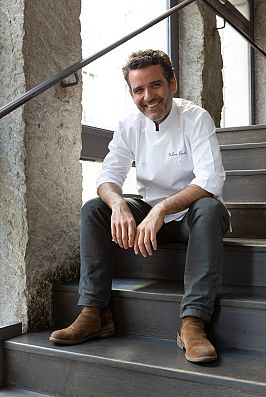The French take their chicken seriously, and Bresse chicken is known to be the best.
French chef Julien Gautier shares with The Kitchen his Bresse chicken in vinegar recipe, a traditional preparation from the city of Lyon.
The French take their chicken seriously, and volaille de Bresse, or poulet de Bresse, is known to be the best. Bresse is the only breed in the country to benefit from the Appellation d'Origine Contrôlée (appellation of origin), meaning it has very regulated breeding and hence a very distinct taste.
Contrary to what the term "poultry" or "volaille" actually means, that is, any kind of domestic fowl such as turkey, or duck, or goose, volaille de Bresse means chicken of Bresse.
Bresse is not far away from Lyon, where Chef Gautier is based, so the AOC chicken is a signature dish at M restaurant, one of the establishments he runs. He prepares it according to the Lyon tradition, with vinegar and cream.
Cooking the chicken in vinegar allows highlighting both the sweetness of the chicken and the balanced acidity of the vinegar. The cream gives it a French-perfect richness.
Bresse chicken cooked in vinegar
Serves: 4
Cooking time: 1 hour and 20 minutes.
Ingredients :
- 1 Bresse chicken, or a free-range good quality chicken.
- 0,2 litres of red wine vinegar
- 0,3 litres of cream
- 4 shallots, peeled and finely cut.
- 4 cloves of garlic, peeled and finely minced.
- 25 grams of butter
- 10 grams of olive oil
- 0.5 litres of chicken broth
- For the broth:
- 1 or 2 carrots, peeled and chopped into 2 cm pieces.
- 1 onion, peeled and chopped into 2 cm pieces.
- 1 green leek, cleaned and chopped into 2 cm pieces.
- 1 clove of garlic, peeled and chopped into 2 cm pieces.
- 1 sprig of thyme
- 1 bay leaf
- 1 chicken carcass (from the whole Bresse chicken above)
Method
- Cut your chicken: remove the legs and breasts, and set them aside. (This might sound intimidating but it's a basic cooking technique. When mastered, it can be done in about a minute and save you some money. If the method is totally unfamiliar, search for a quick how-to cut up a whole chicken on Youtube. Take your time, you’ll see it’s easy and rewarding.)
- Now make the broth. Grab a big pot, add about a litre of water with the chicken carcass and the chopped vegetables. Cook for 45 minutes on medium heat.
- Meanwhile, grab a big skillet and heat up the oil and butter over medium heat, once hot, brown the chicken breasts until golden brown. Now deglaze: add the wine vinegar and scrape up the browned elements in the bottom of the skillet. Cook over medium heat for 3 to 4 minutes, leaving the liquid to reduce. Set the chicken aside.
- In the same pan, sweat the shallots and garlic, until translucent. About 4 minutes.
- If your broth is ready, filter and recover the liquid and add 0.5 litres of it to the pan.
- Add the breast and thighs to finish cooking, over medium heat, then add the crème Fraiche. After about 5 minutes, the sauce should be creamy and smooth. Adjust salt and pepper and serve with rice pilaf.
- Food and wine pairing: a white wine such as the Roussane from Domaine Cuilleron.
For a non-alcoholic pairing: a cox's apple juice from Alain Milliat.
About the chef
Chef Julien Gautier grew up between his mother's kitchen and his grandfather's vegetable garden, before offering his talents as a pastry chef from the sixth grade.
Fast forward to today, Gautier runs the kitchen at both Le Bouchon Sully, a well-known restaurant that honours the city of Lyon’s traditional specialities, and M Restaurant, the establishment where Chef Mathieu Viannay obtained his first Michelin star in 2005. Bresse chicken cooked in vinegar recipe is a classic at M Restaurant.












